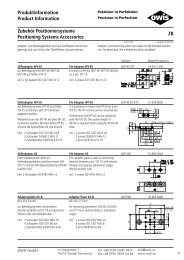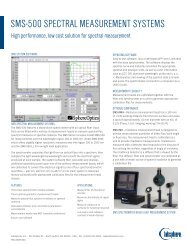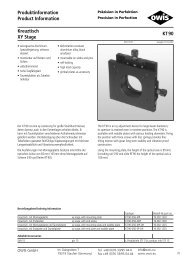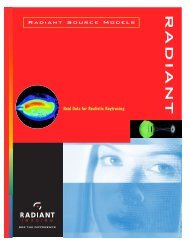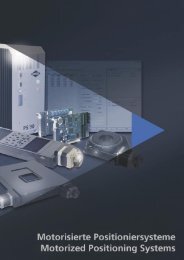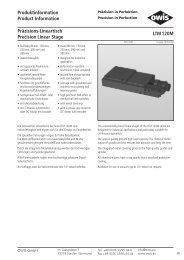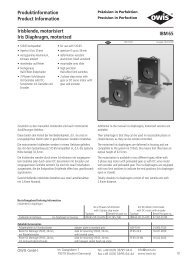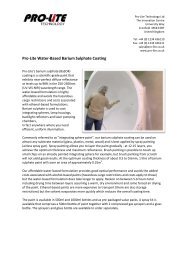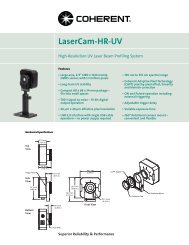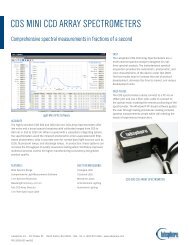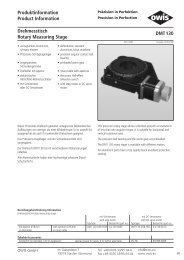Choosing the Right Sphere Size for Your Application - Labsphere
Choosing the Right Sphere Size for Your Application - Labsphere
Choosing the Right Sphere Size for Your Application - Labsphere
Create successful ePaper yourself
Turn your PDF publications into a flip-book with our unique Google optimized e-Paper software.
Unlike <strong>the</strong> traditional integrating sphere coatings which need to be recoated or repackedon a yearly basis to maintain high reflectivity, Spectralon maintains its reflectance indefinitelyunder normal laboratory conditions.Given <strong>the</strong> advantages of integrating sphere reflectance accessories <strong>for</strong> <strong>the</strong> measurementof diffuse and total reflectance or transmittance, it is easy to see that such an accessory isuseful <strong>for</strong> many laboratory applications. However, many spectrophotometers have availableboth internal sample compartment accessories, with 50-60 mm diameter spheres, andexternal reflectance accessories, with 150 mm diameter spheres. How does a user decidebetween <strong>the</strong> large and small diameter integrating spheres when choosing an accessory?Let’s take a look at some of <strong>the</strong> principal advantages and limitations of each.Integrating <strong>Sphere</strong>Efficiency andThroughputSpectrum Noise LevelPort FractionSmaller integrating spheres are efficient collectors of light. The throughput of <strong>the</strong> system,that is, <strong>the</strong> amount of incident light which reaches <strong>the</strong> detector, is governed by <strong>the</strong> laws ofprobability. In a small integrating sphere, a photon will have to take a certain number ofbounces be<strong>for</strong>e it reaches <strong>the</strong> detector. In a larger sphere system, however, statistics dictatethat a photon will have to take more bounces than were required in <strong>the</strong> smaller integratingsphere to reach <strong>the</strong> same detector. In <strong>the</strong> larger sphere, since more “bounces” are required,<strong>the</strong> photon must undergo many more interactions with <strong>the</strong> sphere wall and, <strong>the</strong>re<strong>for</strong>e, ismore likely to be absorbed be<strong>for</strong>e it actually reaches <strong>the</strong> detector. Thus, a large 150 mmintegrating sphere acts as an attenuator of signal and is inherently less efficient than a 60mm diameter sphere. The larger <strong>the</strong> sphere, <strong>the</strong> greater <strong>the</strong> attenuation which results. 2A rule of thumb, all o<strong>the</strong>r factors being equal, is that <strong>the</strong> relative attentuation is roughlyequal to <strong>the</strong> square of <strong>the</strong> ratio between <strong>the</strong> two sphere diameters. As we’ll present, thingsare not always equal, so this rule can only be used as a rough guide.A sphere’s efficiency may play an important role in <strong>the</strong> measurement of highly absorbingsamples. When <strong>the</strong> high absorbance sample being tested limits <strong>the</strong> amount of light reaching<strong>the</strong> sphere’s detector, a high throughput, small diameter sphere will generate betterspectra with less noise than a larger sphere mounted to <strong>the</strong> same spectrophotometer andusing <strong>the</strong> same detector. Thus, spectral results of small spheres tend to have greater signalto-noiselevels than those of larger spheres. In addition, <strong>the</strong> small sphere does not attenuate<strong>the</strong> instrument’s sample beam as significantly as a large diameter sphere, <strong>the</strong>reby onlyslightly affecting <strong>the</strong> overall linearity range of <strong>the</strong> instrument. 3Ideally, <strong>the</strong> integrating sphere accessory design should be flexible enough to allow <strong>the</strong>user to optimize <strong>the</strong> sphere diameter based on <strong>the</strong> application’s required size, numberof port openings and peripheral devices. While this is often true <strong>for</strong> those who purchasestand-alone integrating spheres as general equipment <strong>for</strong> optical laboratories, customersof spectrophotometer reflectance accessories generally have access only to generic spheredesigns which cannot be modified to fit individual needs. In this case, it is important tounderstand <strong>the</strong> effects which <strong>the</strong> sphere’s diameter and port fraction have on <strong>the</strong> per<strong>for</strong>manceof <strong>the</strong> integrating sphere accessory.The port fraction is defined as <strong>the</strong> ratio of <strong>the</strong> total port area relative to <strong>the</strong> total internalsurface area of <strong>the</strong> sphere. 2,4 All beam entrance ports, sample ports, and detector portswhich are filled with material of lower reflectance than <strong>the</strong> Spectralon sphere wall contributeto <strong>the</strong> calculated port fraction. The port fraction is significantly lower <strong>for</strong> 150 mmdiameter spheres than it is <strong>for</strong> 60 mm spheres. For example, <strong>the</strong> port fraction of a representative<strong>Labsphere</strong> 150 mm double beam integrating sphere accessory is 2.5 %, while a60 mm sphere <strong>for</strong> <strong>the</strong> same instrument has a port fraction of 11.3%. The design of both2
accessories includes sample and reference beam transmittance and reflectance ports, as wellas PMT and PbS detector ports.In order to adhere to many ASTM and CIE methods <strong>for</strong> measurements using integratingspheres, <strong>the</strong> port fraction of <strong>the</strong> sphere must be minimized. For instance, CIE recommends 4that <strong>the</strong> sphere’s port fraction be lower than 10% <strong>for</strong> color reflectance measurements,whereas ASTM D1003-95 requires 5 <strong>the</strong> sphere to have a total port fraction less than4% <strong>for</strong> haze measurements on transparent plastics. Thus, 150 mm diameter integratingspheres can be used <strong>for</strong> <strong>the</strong>se methods. A 60 mm diameter integrating sphere with <strong>the</strong>standard transmittance, reflectance, and detector ports is often unable to meet <strong>the</strong>se strictport fraction requirements.A low port fraction ensures good integration of <strong>the</strong> sample signal be<strong>for</strong>e it reaches <strong>the</strong>sphere’s detector. The influence of port fraction on sphere radiance is discussed fur<strong>the</strong>rin <strong>the</strong> section entitled “Measurement Accuracy.”Measurement Accuracy<strong>Sphere</strong> Baffle DesignThe Perfect <strong>Sphere</strong>a balance betweenproper baffle designand light integrationObviously, <strong>the</strong> integrating sphere’s design will affect its measurement accuracy. The sizeand location of ports, detectors, and baffles will influence how <strong>the</strong> light bounces around<strong>the</strong> sphere. As will be discussed in this section, large 150 mm diameter spheres have betterlight integration and <strong>the</strong>ir measurements are less likely to be affected by hot spots. The signalintegration is not as good in smaller spheres, and <strong>the</strong> large port fraction typically foundin 60 mm spheres can introduce significant errors in measurement due to flux loss. 2,6 Allof <strong>the</strong>se factors must be considered when choosing an integrating sphere accessory whichis appropriate to <strong>the</strong> user’s application.When designing integrating spheres <strong>for</strong> sample measurements, it is important that <strong>the</strong>detector’s field of view does not include any portion of <strong>the</strong> sphere surface directly irradiatedby <strong>the</strong> sample beam or <strong>the</strong> first reflection from <strong>the</strong> sample. 2,6,7 This would introducea false response into <strong>the</strong> measurement. Baffles are typically made from thick pieces ofSpectralon or from metal which has been coated with <strong>the</strong> same material as <strong>the</strong> integratingsphere wall. Baffles are used to block <strong>the</strong> detector’s view of light which has not undergoneat least two reflections from <strong>the</strong> sphere surface. Thus, <strong>the</strong> baffle is positioned to prevent<strong>the</strong> so-called ‘first-strike’ reflections from entering <strong>the</strong> field of view of <strong>the</strong> detector.The size and position of baffles within <strong>the</strong> integrating sphere are very important factorswhich influence <strong>the</strong> system’s measurement accuracy. As described in ASTM E903, “largeerrors can arise if <strong>the</strong> angular distribution of <strong>the</strong> light reflected from <strong>the</strong> specimen is differentfrom that reflected by <strong>the</strong> standard. 6 ”An example is given in transmittance measurementsof translucent samples. Measurement errors may occur since <strong>the</strong> translucent sample, whichscatters light, is measured relative to <strong>the</strong> nonscattering open port (air), which is used <strong>for</strong><strong>the</strong> background correction as a standard. Careful baffle design can substantially reduceerrors due to <strong>the</strong> different light scattering distribution of samples and standards. However,baffle design must always be per<strong>for</strong>med with respect to <strong>the</strong> overall radiance characteristicsof <strong>the</strong> sphere. The balance between baffle design and sphere flux is an important considerationwhen choosing an integrating sphere design.The distribution of light within an integrating sphere will drastically affect its measurementaccuracy. While small spheres do have higher energy efficiency than <strong>the</strong>ir 150 mmdiameter counterparts, large integrating spheres will yield measurements with greateraccuracy since <strong>the</strong> light in large systems can be ‘integrated’ or distributed evenly about<strong>the</strong> sphere’s surface. The large internal surface area and <strong>the</strong> small overall port fraction of150 mm spheres allows <strong>the</strong> light to reflect properly around <strong>the</strong> sphere, creating a homogeneousflux. However, in <strong>the</strong> design of small integrating sphere accessories, sphere fluxhomogeneity must often be compromised in an attempt to reduce <strong>the</strong> effects of hot spots.3
Substitution ErrorsHot spots are areas within <strong>the</strong> sphere which appear brighter to <strong>the</strong> sphere’s detectors thano<strong>the</strong>r portions of <strong>the</strong> sphere. Measurement errors, sometimes termed 7 regular reflectancescreening errors, can result from hot spots, especially when measuring glossy or specular,mirror-like samples. The reflectance of mirrors may appear higher than <strong>the</strong> true value if<strong>the</strong> sphere’s detectors are not baffled from <strong>the</strong> spot on <strong>the</strong> sphere wall where <strong>the</strong> first-strikeradiation hits. As described above, spheres are designed with baffles between <strong>the</strong> detectorsand each sample port to minimize such occurrences. A sphere’s baffles are intended toeliminate hot spots or to shield <strong>the</strong> sphere’s detectors from viewing <strong>the</strong>m directly. 2,6,7Hot spots are more prevalent in small 60 mm diameter spheres. In <strong>the</strong>se spheres, it isoften impossible to design baffles to <strong>the</strong> proper dimensions needed to adequately shield<strong>the</strong> sphere’s detector from view of a sample port or ano<strong>the</strong>r bright spot. In small spheres,<strong>the</strong> sizes of baffles must often be minimized. The problem is one of real estate—<strong>the</strong>re isjust not enough space to fit properly sized baffles into <strong>the</strong> 60 mm diameter sphere in <strong>the</strong>proper places. Often <strong>the</strong> final integrating sphere baffle design is a compromise between<strong>the</strong> ideal baffle size which will fully shield <strong>the</strong> detector and a smaller baffle size whichwill interfere less with <strong>the</strong> sphere’s flux homogeneity.Small integrating spheres which are used on single or dual beam (beamsplitter-based)spectrophotometers are subject to sample substitution errors. Due to <strong>the</strong> dual beam instrument’scharacteristics, only <strong>the</strong> sample beam can be placed into <strong>the</strong> integrating sphere, and<strong>the</strong> reference beam must remain outside. The single beam substitution error which occursduring color measurements using such spheres is <strong>the</strong> systematic, predictable, and nonrandomerror inherent in single beam integrating spheres measuring reflectance or transmittance.The error is caused by <strong>the</strong> difference in <strong>the</strong> throughput of <strong>the</strong> sphere when <strong>the</strong>reference makes up a portion of <strong>the</strong> sphere wall and when <strong>the</strong> sample is substituted <strong>for</strong><strong>the</strong> reference. 7,8 Integrating sphere accessories that are used on double beam spectrophotometers,or those instruments which utilize a beam chopper, are not subject to this errorsince both <strong>the</strong> sample and reference beams can be located in <strong>the</strong> sphere at <strong>the</strong> same time.Single beam substitution errors can approach 10%R <strong>for</strong> diffuse reflectance samples. 8In quality control applications where a threshold value is used, this may not be a concern,as <strong>the</strong> error can simply be built into <strong>the</strong> threshold. This is also true if only peak positionin<strong>for</strong>mation is required, as single beam correction only concerns <strong>the</strong> photometric scale.When a sample and a reference are of similar reflectance, <strong>the</strong> substitution correction isvery small. If <strong>the</strong> sphere is made sufficiently large and <strong>the</strong> area of <strong>the</strong> sample is minimized,<strong>the</strong> error diminishes. However, <strong>the</strong> use of a large sphere is usually not practical in low costspectrophotometer systems due to signal-to-noise concerns as well a price considerations.Consult <strong>the</strong> references <strong>for</strong> fur<strong>the</strong>r explanation of single beam substitution error andmethods of correction. 3,4,7,8Sample Beam <strong>Size</strong>Due to <strong>the</strong>ir size, 150 mm integrating sphere accessories have proportionally larger samplebeam spot sizes, typically 50% larger than those of small 60 mm spheres. A large spot sizeis an advantage <strong>for</strong> inhomogeneous samples, where large beam coverage ensures representativereflectance measurements over <strong>the</strong> entire surface of <strong>the</strong> test sample. However, <strong>the</strong>typical large beam size of <strong>the</strong> 150 mm integrating sphere accessory is not optimized <strong>for</strong> <strong>the</strong>measurement of samples smaller than one inch in diameter. For such small samples, <strong>the</strong>sample beam must be reduced so that it does not overfill <strong>the</strong> sample. Two methods can beused to reduce <strong>the</strong> size of <strong>the</strong> sample beam so it better matches small samples; ei<strong>the</strong>r a lenscan be used (in conjunction with a small spot kit) to focus <strong>the</strong> beam down, or <strong>the</strong> samplecan be masked so that <strong>the</strong> correct portion of <strong>the</strong> beam strikes <strong>the</strong> sample. Both beam reductionmethods result in sometimes considerable loss in beam energy, which can increase <strong>the</strong>noise in <strong>the</strong> scan and will require slower scan times to compensate <strong>for</strong> <strong>the</strong> energy loss.4
Design OptionsConclusionWhile all sizes of integrating sphere accessories are able to measure diverse samples suchas powders, liquids in cuvettes, and translucent or opaque solids such as fabrics or syringes,<strong>the</strong> 150 mm diameter integrating sphere has extended sampling options that are unavailableon its smaller counterpart. Integrating spheres of 150 mm diameter or greater are able toaccept center mount sample holders. These center mounts enable variable angle reflectancemeasurements of opaque samples, absorptance scans of thin films or translucent samples,or fixed angle liquid measurements to be per<strong>for</strong>med. In addition, <strong>the</strong> standard 150 mmsphere accessories have removable reflectance port covers <strong>for</strong> <strong>the</strong> measurement of large orbulky samples. O<strong>the</strong>r sampling or customization options are available only <strong>for</strong> 150 mmintegrating spheres designs, such as downward viewing reflectance ports or large transmittancesample compartments <strong>for</strong> bulky samples, adapters <strong>for</strong> polarizers, or sample beamattenuation <strong>for</strong> small beam spot sizes.While consideration is needed in determining <strong>the</strong> proper sphere size required to achieveoptimal per<strong>for</strong>mance <strong>for</strong> your spectrophotometer, <strong>the</strong> process is made easier when oneunderstands <strong>the</strong> advantages and limitations of <strong>the</strong> accessories. We hope this article has provideda useful tool to aid in your selection process.5
Comparison of <strong>Sphere</strong> Accessories150 mm Diameter Integrating <strong>Sphere</strong>ADVANTAGESAvailability• Available <strong>for</strong> high-end, double beam spectrophotometers.Port Fraction• Low port fraction—typically 2–4%. Meets CIE color measurementspecifications.Measurement Accuracy• Highest measurement accuracy is achieved with large integratingspheres since sphere errors can be minimized, resulting in veryhomogeneous light flux and minimal hot spots in sphere.Substitution Errors• Double beam integrating spheres—no sample substitution errors.Sample Beam <strong>Size</strong>• Large sample beam size—good coverage of inhomogeneous samples.Design Options/Description• Accessory is more flexible—can accommodate various sphere designssuch as center mount sample holder, small spot optics, or downwardviewing reflectance port.• External compartment accessory—can measure reflectance of largesamples using <strong>the</strong> external ports with removable covers.• More room to design custom sample holders <strong>for</strong> reflectance ortransmittance samples—not limited by size of spectrophotometer’ssample compartment.• Uses sensitive PMT (200–850 nm) and PbS (850–2500 nm)detectors.LIMITATIONSAvailability• Not available <strong>for</strong> many moderately priced single or dual beamspectrophotometers.<strong>Sphere</strong> efficiency• Not as efficient as smaller spheres—large sphere diameter attenuates<strong>the</strong> sample beam energy more than a small sphere of similar design.Noise Level• Signal-to-noise may be lower <strong>for</strong> highly absorbing samples (mayhave to per<strong>for</strong>m scans at larger slit widths, slower scan speeds, orwith reference beam attenuation to compensate).Sample Beam <strong>Size</strong>• Large sample beam spot size overfills small test samples, requiringmasking or small spot kits which lead to additional energy loss.Design Options/Description• Out-of-compartment accessory—may be subject to stray light effects.• Often more difficult to use—may be harder to install, optical alignmentmay be more complicated.• Usually cannot be equipped with silicon photodiode (200–1100 nm)detector.Cost• More expensive (more optics, typically two detectors and preamplifierboards).60 mm Diameter Integrating <strong>Sphere</strong>ADVANTAGESAvailability• Available <strong>for</strong> moderately priced single, dual, and double beamspectrophotometers.<strong>Sphere</strong> efficiency• Smaller spheres are more efficient collectors—in general, more energyreaches detector.Noise Level• Higher throughput systems, <strong>the</strong>re<strong>for</strong>e signal-to-noise is usuallybetter, especially <strong>for</strong> highly absorbing samples (Note—also dependson linearity range of instrument).Sample Beam <strong>Size</strong>• Smaller sample beam spot size better matches small test samples, noneed to mask or use small spot kits which lead to throughput loss.Design Options/Description• In compartment accessory—generally not subject to light leaks.• Simple to use—easy to install and remove accessory (once electronicsare in place, if applicable), optical alignment is more straight<strong>for</strong>ward.• Accessories with small spheres can be equipped with ei<strong>the</strong>r PMT(200–850 nm) or silicon photodiode (200–1100 nm) detectors,depending on spectrophotometer.Cost• Less expensive (fewer optics, typically one detector only).LIMITATIONSAvailability• Often not available <strong>for</strong> high-end, double beam spectrophotometers.Port Fraction• High port fraction—typically above 10%. <strong>Sphere</strong> does not meet CIEcolor measurement specifications.Measurement Accuracy• <strong>Sphere</strong> errors or hot spots may occur in small spheres—errors maynot be completely corrected by a sphere’s baffles due to space constraints,which often prohibit placement of correctly sized baffles intoa small sphere’s interior.Substitution Errors• Small integrating spheres on single or dual beam spectrophotometersare subject to sample substitution errors, which can approach 10%R<strong>for</strong> diffuse samples.Sample Beam <strong>Size</strong>• Small sample beam size means multiple locations must be measuredon inhomogeneous samples.Design Options/Description• Accessory design is less flexible—cannot accommodate special spheredesigns such as center mount sample holder or downward viewingreflectance port.• Cannot measure reflectance or transmittance of extremely largesamples inside <strong>the</strong> spectrophotometer’s sample compartment.• Limited ability to design custom sample holders <strong>for</strong> reflectance ortransmittance samples—limited by size of sample compartment.6
References1. Spectralon. ® A proprietary diffuse reflecting material ideal <strong>for</strong> applications ranging from<strong>the</strong> UV-VIS to <strong>the</strong> NIR wavelength region. For additional technical in<strong>for</strong>mationabout Spectralon, consult <strong>the</strong> <strong>Labsphere</strong> Diffuse Reflectance Coatings and MaterialsCatalog.2. Carr, K.F., “A Guide to Integrating <strong>Sphere</strong> Theory and <strong>Application</strong>s,” <strong>Labsphere</strong>Technical Guide, 1997.3. Springsteen, A., “A Guide to Reflectance Spectroscopy,” <strong>Labsphere</strong> Technical Guide,1992.4. CIE 15.2, Colorimetry, International Commission on Illumination, Second Edition(1986).5. ASTM D 1003-95, “Standard Test Method <strong>for</strong> Haze and Luminous Transmittanceof Transparent Plastics.”6. ASTM E 903-82 (Reapproved 1992), “Standard Test Method <strong>for</strong> Solar Absorptance,Reflectance, and Transmittance of Materials Using Integrating <strong>Sphere</strong>s.”7. Clarke, F.J.J. and Compton, J.A., “Correction Methods <strong>for</strong> Integrating-<strong>Sphere</strong>Measurement of Hemispherical Reflectance,” Color Research and <strong>Application</strong> 11 (4),253 (1986).8. Springsteen, A., Ricker, T.M., Blanchard, S.S., and Dwyer, K.A., “Quantitation ofSingle Beam Substitution Correction in Reflectance Spectroscopy Accessories,”<strong>Labsphere</strong> <strong>Application</strong> Note 01 (1996).7
UNITED STATES GERMANY FRANCE UNITED KINGDOM0002-500<strong>Labsphere</strong>, Inc. <strong>Labsphere</strong>-Germany <strong>Labsphere</strong>-France <strong>Labsphere</strong> Ltd.Tel: (603) 927-4266 Tel (49) 0 7556 50107 Tel: (33) 01 60 92 05 04 Tel: (44) 0 1625 871188Fax: (603) 927-4694 Fax: (49) 0 7556 50108 Fax (33) 01 60 92 04 95 Fax: (44) 0 1625 871778Email: labsphere@labsphere.com Email:wolfboehme@T-Online.de Email: labsphere@wanadoo.fr Email: labsphereuk@compuserve.com



